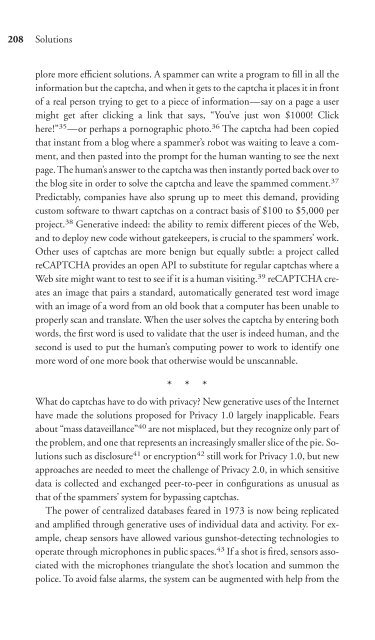Download - Future of the Internet â And how to stop it.
Download - Future of the Internet â And how to stop it.
Download - Future of the Internet â And how to stop it.
You also want an ePaper? Increase the reach of your titles
YUMPU automatically turns print PDFs into web optimized ePapers that Google loves.
208<br />
Solutions<br />
plore more efficient solutions. A spammer can wr<strong>it</strong>e a program <strong>to</strong> fill in all <strong>the</strong><br />
information but <strong>the</strong> captcha, and when <strong>it</strong> gets <strong>to</strong> <strong>the</strong> captcha <strong>it</strong> places <strong>it</strong> in front<br />
<strong>of</strong> a real person trying <strong>to</strong> get <strong>to</strong> a piece <strong>of</strong> information—say on a page a user<br />
might get after clicking a link that says, “You’ve just won $1000! Click<br />
here!” 35 —or perhaps a pornographic pho<strong>to</strong>. 36 The captcha had been copied<br />
that instant from a blog where a spammer’s robot was wa<strong>it</strong>ing <strong>to</strong> leave a comment,<br />
and <strong>the</strong>n pasted in<strong>to</strong> <strong>the</strong> prompt for <strong>the</strong> human wanting <strong>to</strong> see <strong>the</strong> next<br />
page. The human’s answer <strong>to</strong> <strong>the</strong> captcha was <strong>the</strong>n instantly ported back over <strong>to</strong><br />
<strong>the</strong> blog s<strong>it</strong>e in order <strong>to</strong> solve <strong>the</strong> captcha and leave <strong>the</strong> spammed comment. 37<br />
Predictably, companies have also sprung up <strong>to</strong> meet this demand, providing<br />
cus<strong>to</strong>m s<strong>of</strong>tware <strong>to</strong> thwart captchas on a contract basis <strong>of</strong> $100 <strong>to</strong> $5,000 per<br />
project. 38 Generative indeed: <strong>the</strong> abil<strong>it</strong>y <strong>to</strong> remix different pieces <strong>of</strong> <strong>the</strong> Web,<br />
and <strong>to</strong> deploy new code w<strong>it</strong>hout gatekeepers, is crucial <strong>to</strong> <strong>the</strong> spammers’ work.<br />
O<strong>the</strong>r uses <strong>of</strong> captchas are more benign but equally subtle: a project called<br />
reCAPTCHA provides an open API <strong>to</strong> subst<strong>it</strong>ute for regular captchas where a<br />
Web s<strong>it</strong>e might want <strong>to</strong> test <strong>to</strong> see if <strong>it</strong> is a human vis<strong>it</strong>ing. 39 reCAPTCHA creates<br />
an image that pairs a standard, au<strong>to</strong>matically generated test word image<br />
w<strong>it</strong>h an image <strong>of</strong> a word from an old book that a computer has been unable <strong>to</strong><br />
properly scan and translate. When <strong>the</strong> user solves <strong>the</strong> captcha by entering both<br />
words, <strong>the</strong> first word is used <strong>to</strong> validate that <strong>the</strong> user is indeed human, and <strong>the</strong><br />
second is used <strong>to</strong> put <strong>the</strong> human’s computing power <strong>to</strong> work <strong>to</strong> identify one<br />
more word <strong>of</strong> one more book that o<strong>the</strong>rwise would be unscannable.<br />
* * *<br />
What do captchas have <strong>to</strong> do w<strong>it</strong>h privacy New generative uses <strong>of</strong> <strong>the</strong> <strong>Internet</strong><br />
have made <strong>the</strong> solutions proposed for Privacy 1.0 largely inapplicable. Fears<br />
about “mass dataveillance” 40 are not misplaced, but <strong>the</strong>y recognize only part <strong>of</strong><br />
<strong>the</strong> problem, and one that represents an increasingly smaller slice <strong>of</strong> <strong>the</strong> pie. Solutions<br />
such as disclosure 41 or encryption 42 still work for Privacy 1.0, but new<br />
approaches are needed <strong>to</strong> meet <strong>the</strong> challenge <strong>of</strong> Privacy 2.0, in which sens<strong>it</strong>ive<br />
data is collected and exchanged peer-<strong>to</strong>-peer in configurations as unusual as<br />
that <strong>of</strong> <strong>the</strong> spammers’ system for bypassing captchas.<br />
The power <strong>of</strong> centralized databases feared in 1973 is now being replicated<br />
and amplified through generative uses <strong>of</strong> individual data and activ<strong>it</strong>y. For example,<br />
cheap sensors have allowed various gunshot-detecting technologies <strong>to</strong><br />
operate through microphones in public spaces. 43 If a shot is fired, sensors associated<br />
w<strong>it</strong>h <strong>the</strong> microphones triangulate <strong>the</strong> shot’s location and summon <strong>the</strong><br />
police. To avoid false alarms, <strong>the</strong> system can be augmented w<strong>it</strong>h help from <strong>the</strong>


